

|
Back to |
| The Front Page |
| News & Features |

|
Sarasota: The art and science of club building
|
|
by Bob Alman photos by Fred Jones layout by Reuben Edwards Posted December 7, 2007
|
In any contest for the most distinguished all-around croquet couple in America, Jackie and Fred Jones would be finalists. Long before the establishment of the Sarasota County Croquet Club, they had already carved a secure place for themselves in American croquet history: Fred as a popular director of croquet tournaments and longtime Florida region VP of the USCA; Jackie as one of the most trophied American women in the sport. But the remarkable Sarasota Club may turn out be the couple's most enduring legacy. Just a few years old, it's already among the biggest on the continent in membership; with three full lawns, it has the biggest court capacity of any public croquet facility on the continent and plenty of room for more growth. Any new or aspiring club would do well to study this development model for clubs in either the public or private sphere, and on any continent.
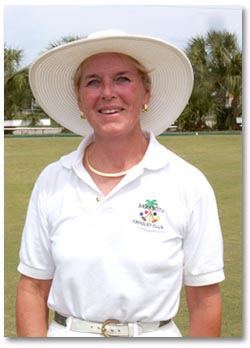
|
| Over the past decade, Jackie Jones has established herself as the most competitive female in American croquet on the courts. Her work with the Sarasota club makes her also one of the sport's most successful organizers. |
If the Sarasota Club is not universally applicable as a model for club development, there are good reasons. For one thing, the members are predominantly retirees; but that is entirely to be expected in a South Florida region hugely populated by older couples moving south with the sun, as Fred and Jackie themselves have done. And Sarasota has not developed any top-level players yet, of the stature of Jackie or Fred, but it's too young a club to expect that. Jackie and Fred have not replicated themselves yet in the management structure; but they're working on it.
All those quibbles are nothing compared with the substantial accomplishment the club represents, mostly because of Jackie's determination to make it happen. Fred makes it very clear: This club is mostly Jackie's doing: "I told her when she was starting out that I would help, but that this club was going to have to be her baby, and it was going to be a lot of work," Fred recalls. He was right. But neither of them has any regrets.
Natural leadership charisma always helps
Jackie Jones is a perfect subject of an AARP cover story. Combining croquet chic and CEO-style assertiveness in her white slacks and blue blazer, she's croquet's poster-girl - active, slim, attractive, outgoing, articulate, and determined to accomplish her goals, whether in competing with men in top tournaments or going hunting for public turf for her croquet club.
Jackie guides the destiny of the club with the unfettered enthusiasm of the dedicated amateur, combined with the energy and expertise of the professional. She gets no pay - not a penny - and neither does Fred. Fred also has high professional-level standards as one of the most experienced and popular tournament directors for USCA sanctioned events - a demanding job for which he is paid the standard fees. The couple travel often on tournament-directing gigs in the summer, when Florida is relatively hot and steamy.

|
| Singly and as partners, Jackie and Fred have won too many prestigous trophies to ennumerate here, including the doubles championship of the USCA Seniors & Masters in both 2003 and 2004, at the National Croquet Center. |
|
in our Readers' Forum on Club Development |
|
Readers everywhere are invited to comment on any aspect of this story or on your own club building experiences in your country. To make a posting, simply hit the SUBMIT A POSTING button at the top of the Bulletin Board Index, select "Forum" as the category, then select the "Club Development Models" topic from the pull-down and follow the menu. This Forum on Club Development is designed to stay online indefinitely, clearly indexed and accessible for reading or for adding comment at any time.
|
When Fred told Jackie the Sarasota Club was her baby, it wasn't from laziness. He teaches croquet two days a week at private facilities in Naples and two days a week at Boca Grande, in addition to running USCA tournaments all around Florida and the East Coast. But Fred has announced his "retirement" as USCA Vice President of the Florida region - the USCA's most populous - and it's a good guess that he'll invest some of that leftover energy into building the remarkable Sarasota Club to even dizzier heights of eminence in the small world of organized croquet.
What might that involve? A prestigious national "open"? Training new champions of the sport? Developing a corps of young and ambitious players hungry to win national championships? All of that. And when it happens, you can be sure it will appear in the local press.
Creating buzz in local media
Long before the ribbon-cutting ceremony for the new 3-lawn facility in January of 2005, Jackie made sure the press and VIP bureaucrats knew all about the facility, the game, and the prospects. She invited a journalist from the Herald-Tribune for novice golf croquet, who expressed some disappointment that the three lawns were laid out alongside Pinebrook Road, with all the noise and distraction of passing traffic. But Jackie let him know it was all part of the plan: "This site is wonderful for us," she told the journalist, "because we're getting great exposure. People will see us and become interested and inquire and decide to try it out; and if lots of people try it out then lots of them will like it. We've just got to get 'em out here," Jackie said. "That's the secret." All that was directly quoted by the journalist in the newspaper article that helped build the crowds at Jackie's free introductory public events.
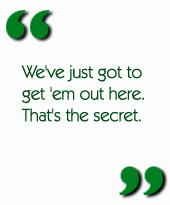 Jackie found out that the public court formula that worked in Manhattan's Central Park and in San Francisco's Stern Grove can work even better in Venice at Wellfield Park - because there's more lawn space and - more than half the year - perfect weather. When she tells journalists there are only a handful of public croquet facilities in the US, and theirs it the largest, she's not just bragging: She's providing an essential clue to what could become the next generation of growth for organized croquet in America - when it "goes public" in a big way, beyond the hedge-hidden resorts and country clubs that characterize the sport's current image.
Jackie found out that the public court formula that worked in Manhattan's Central Park and in San Francisco's Stern Grove can work even better in Venice at Wellfield Park - because there's more lawn space and - more than half the year - perfect weather. When she tells journalists there are only a handful of public croquet facilities in the US, and theirs it the largest, she's not just bragging: She's providing an essential clue to what could become the next generation of growth for organized croquet in America - when it "goes public" in a big way, beyond the hedge-hidden resorts and country clubs that characterize the sport's current image.
Enlisting government officials to champion the cause
Jackie is the first to acknowledge the key role played by Jack Colligan, manager of area parks for Sarasota County. When he was convinced of the legitimacy of the croquet players' need for a space of their own, he led the search to find the perfect spot - the one locale that had everything the fledgling club needed, and that would ideally fit into its location as an public enhancement instead of a financial or management problem.
That ideal spot turned out to be Wellfield Park, in the city of Venice. Collingan's formula called for building the courts on city park land, but having the county maintain it. In Wellfield Park, the neutral ground between baseball diamond #5 and the street - - which one park official referred to as "dead space" - perfectly fit the club's requirements, and there were bathrooms and water fountains already in place. Collingan's formula called for building the courts on city park land, but having the county maintain it.
Final approval from both city and county did not happen until May 2004, but with the approval in hand, the lawns were quickly built and planted, and were ready for the Grand Opening ceremony in January of 2005. Jackie and Fred made sure that everyone knew this was breakthrough event - with Sarasota County now rightfully boasting the biggest public facility in the Americas.

|
At first, "biggest" referred only to the number of full-sized regulation courts (3). But soon, "biggest" also meant the public club with the most members (160 at last count, all of them members of the USCA .) These figures don't lie. They tell you that Jackie's Sarasota Club contributes a full five percent of the total U.S. Croquet Association membership, more than any other croquet club in America - including the 12-court National Croquet Center in West Palm Beach, Florida.
Press and politicians are equally fond of superlatives. Jackie and Fred have been effective publicists for the Sarasota Croquet Club at every stage in its development, and they make good use of every media hook that presents itself. "I used my ranking as the number one woman in the country," Jackie says, "and when Fred was inducted into the Croquet Hall of Fame, we used that, too. We brag all over the place and to whomever will listen (especially local politicians) that Venice has the largest public dedicated croquet facility in the country."
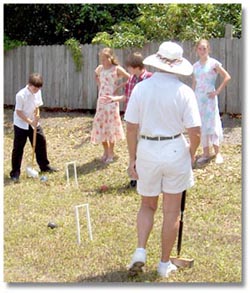
|
| When Jackie is invited to present croquet to a local fifth-grade school, she sets up the games on long grass in a dry retention area. |
The rapid success of the Sarasota County Croquet Club dramatizes the still largely untapped potential of the sport in America. "Most croquet lawns in the country are in country clubs and resorts," Jackie told the park and rec people in the initial phases of her development campaign. "Croquet is just like golf and tennis were in their infancy," she said. "It's starting to take off, but to really grow, there have to be places where the public can see it played and be invited to play themselves." It was a convincing argument, supported by a handful of public court success stories in America, unlike croquet in other countries, where the huge majority of the courts are on public land, and where a much larger percentage of the national population plays croquet and provides visibility for the sport.
Ancient roots nourished the club's rapid development
Like any professional, Jackie always gives due credit, and much credit goes to Ilse Goesmann, who started asking the county for croquet lawns in 1994 and every year after that. Even though she gathered signatures of support and assembled a couple of dozen croquet players, "We were always told that there was no money for croquet," Jackie recalls. Instead, the county urged her to try talking the bowlers into using some of their space. It was the kind of "shotgun wedding" that public jurisdictions with budget issues often urge upon croquet groups because, on paper, it makes lots of sense.
In 2000, croquet was finally allowed on one of the three bowling lawns, but Jackie ruefully recalls that the inevitable happened - the same thing that happens, initially, most places where lawn bowling and croquet try to coexist on the same lawns. '"We have never been welcome sharers of those bowling lawns. The three full-size lawns were dormant most of the time, but the bowlers still did not want to share. It was a very difficult time for the croquet members, but we lived through it, and all to our advantage."
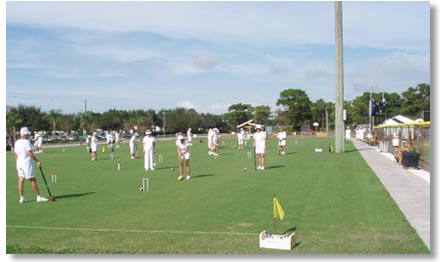
|
| The three courts are build lengthwise along the road. Populated with players in white, they make a powerful promotional statement to passersby. |
Stressful as it was, croquet's growth on the bowling lawns gave croquet an essential toehold in the county. More than 70 dues-paying croquet players on the bowling lawns showed the public officials there was a demand for the sport. And when the time came to "show the money" to the county as a token of the club's commitment, Jackie had recruited a dedicated group she could call on to raise $5,000 she promised to the City Council to help build the lawns. "Within nine days of putting out the call," Jackie remembers, "we had the money. Keeping that promise so promptly sealed the deal.
Ironically, the bickering between the lawn bowlers and the croquet players was a factor in motivating the park and rec officials to find another venue for croquet - to restore peace. Croquet had been allowed on only one of the three lawns, so its growth beyond 75 on one lawn had became problematic. The members of both clubs are much happier on their own.
Keeping the agreements, fulfilling the promises
City and county jurisdictions are often willing to meet croquet organizers more than halfway to the goal, if the organizers can demonstrate a solid and sustained commitment to whatever they are proposing. "We never asked for a handout," Jackie emphasizes the point, noting that that members committed to raising $10,000 to help pay for the $35,000 cost of building the lawns, as well as buying a special mower as well as a storage shed, The Venice City Council also put up $3,500 for a protective fence to shield the lawns from vandals and unauthorized use.
The shed to house the lawn mower and equipment was to be paid for from a treasury built up from accumulated membership and tournament fees. "We found a very nice looking 12 x 24 shed for $5400, "Jackie recalls," which we were glad to donate to city, and it became a perfectly serviceable little clubhouse - with a refrigerator, fans, and lights, and a water line right outside the door. It a little like camping, but it works very well for us."
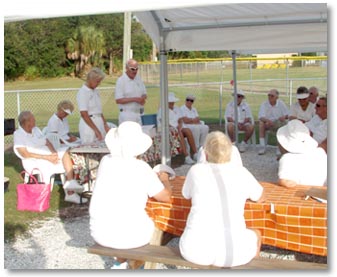
|
| The day's croquet competition is organized in a courtside shelter. |
It was hard work, and Jackie has no regrets about it. Nothing succeeds like success, and she's got it. "I have to admit I'm enjoying it. I feel it's important that I continue as president a little longer if only for my relationship with park and rec, but I'm hoping in the not too distant future that I can pass on the presidency to someone else. We're fortunate to have some very dedicated members who spend lots of time courtside, teaching and encouraging new players - and most of them are pretty new to the sport themselves."
There's a newsy weekly email newsletter done by member Norma Christie; volunteers man calling trees to get people out on the lawns for the regular Thursday member instruction and games and to help with the weekly free public program. And some of the members are becoming proficient coaches and instructors.
The secret of her success: the social factor
Jackie's membership development philosophy is rooted in total-immersion social values, beginning with the initial "introduction" that prospective members come to, and continuing with the group events scheduled weekly for members at various levels of proficiency, and for different games - including Golf Croquet. "I stress the social, fun aspect of croquet more than the competitive side. I feel those who want the competition know exactly what they want and will go after it, but it's my goal to sell croquet from the start as a fun, social thing to do, for either singles or couples."

|
| In a free public introductory course, Jackie first demonstrates, then asks the participants to imitate her swing. |
The regular weekly Tuesday morning free public instruction is followed by an open invitation to everyone to gather at a local restaurant for a Dutch treat lunch. "In season we have had more than 30 for these introductory lessons at lunch. After lunch, everyone is invited to an afternoon of social golf croquet, partnership only, with the new players paired with a member who knows how to play, and with a different partner in each game, so everyone has a chance to get acquainted with more people.
"We have a Thursday morning clinic for members only, and that's also followed by a group lunch for those who are interested, and a lot of people are."
Jackie mandates nametags for all the members at the courts. "I think it makes everyone feel part of the group," Jackie says. "And I need them because I can't remember all the new names."
Although the demographics of the club reflect the "older" population of Saratoga County, not all the members are over sixty. Russ Cuccia, in his early 50s, knew little about the sport of croquet when he started watching the three courts being built in Wellfield Park, two blocks from his home. He'd played the backyard version and wondered how this might be different. But now, he's hooked. Asked if he'll ever go back to backyard croquet, he comments, "They're not even the same game!"
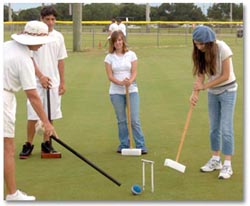
|
| On Thursdays after work when the days are long, 20- and 30-somethings are invited to play Golf Croquet; they could be the nucleus of a "youth club" to expand the organization's demographic makeup. |
To sum up, Jackie Jones has done just about everything right in shepherding the Sarasota Croquet Club to its present eminence. In its infancy, it's already the biggest kid on the block. Already, the club is producing six-lawn tournaments, which puts them in the big league of competitions. With almost as many members as the 12-lawn National Croquet Center, it's easy to imagine the Sarasato Club enlisting the help of the city and county to build even more courts to fuel a second spurt of rapid growth and make Sarasota the biggest club in the Americas.
Jackie could make it happen. She's already done the impossible. And Fred will help.
|
IN THE UNITED STATES AND CANADA |
|
Atlanta Mallet Club, Georgia. Robert Burnett, bobburnett@foxtheatre.org, 404-881-2100. Black Mountain Croquet Club - Black Mountain, NC. Keith Nelon, knelon@hotmail.com, 828-668-4921. Boston Croquet Club, Massachusetts. Mary Catherine Deibel, marycat@upstairsonthesquare.com, 781-643-6821. Buffalo/Olmsted Croquet Club, New York. Bill Cleary, wcleary@adelphia.net, 716-601-0039. Chicago Croquet Club, Illinois. Jeff Lee, JPMLee@aol.com, 708-579-1180. Confederate Hills Croquet Club, Highland Springs, Virginia. Urchie Ellis, UBEllis@worldnet.att.net, 804-272-5923. Denver Croquet Club, Colorado. Ron Eccles, rontseg@comcast.net, 720-937-2056. Detroit Croquet Club, Westland, Michigan. Wayne Fisk, wtfisk@comcast.net, 313-274-0459. Elizabeth Park Croquet Club, Hartford, Connecticut. Dave Earles, drearles@juno.com, 860-873-4056. Germantown Mallet Club, Tennesse. Natalie Ruffin, nruffin@ci.germantown.tn.us, 901-757-7205. Oakland Croquet Club, California. Reuben Edwards, oaklandcroquet@yahoo.com, 510-465-2955. Red Stick Croquet Club, Baton Rouge, Louisiana. Carl Jarratt, 225-926-0428. San Francisco Croquet Club, California. Elaine Fong, SFCroquetClub@aol.com, 415-664-1544. Sarasota County Croquet Club, Florida. Jackie Jones, crokpeople@aol.com, 941-484-3206. Spindletop Croquet Club, Lexington, Kentucky. George Parker, gparker@whitakerbank.com, 502-857-4967. Tulsa Croquet Club, Oklahoma. Robert Ellis Baker, baker111@tulsacoxmail.com, 918-258-5656. Woodlawn Croquet Club, Ellsworth, Maine. Perry Mattson, croquet@woodlawnmuseum.org, 207-667-8671. Mount Royal Country Club, Quebec, Canada. Graham Baker, g.r.baker@sympatico.ca, 514-733-4053. North Toronto Lawn Croquet Club, Ontario, Canada. Paul Emmett, pemmett@sympatico.ca, 416-225-7535. See the complete directory of associated croquet clubs in the US and Canada on the USCA website. |